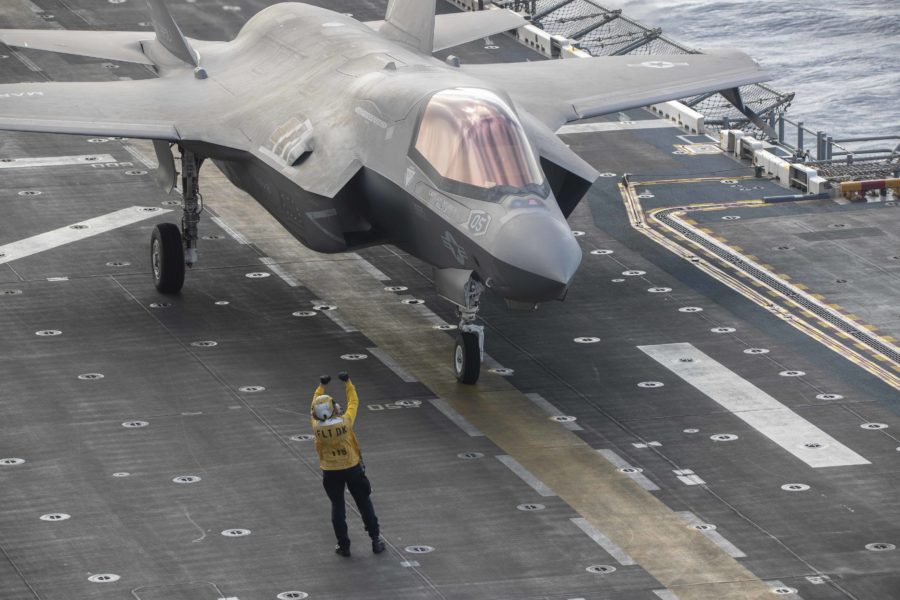Pratt & Whitney has been cleared to restart deliveries of F135 jet engines—two months after the Pentagon ordered a hold on deliveries following the crash of an F-35B in December. But the F-35 Joint Program Office has not yet allowed delivery of 21 already assembled F-35s that were put on hold after the crash.
Industry officials said F-35 jet deliveries could resume the week of Feb. 27.
Deliveries were halted due to the discovery of “a rare system phenomenon involving harmonic resonance,” the JPO said in an emailed statement, echoing word-for-word what Jen Latka, a Pratt & Whitney vice president had said on Feb. 10.
The JPO said it is working with an industry team “to ensure incorporation of mitigation measures that will fully address/resolve this rare phenomenon in impacted F135 engines.”
The government will “provide instructions to the fleet and to Lockheed Martin to enable safe resumption of flight operations of impacted aircraft and new production aircraft,” the statement said.
Pratt scheduled a press conference for Feb. 28 to explain the engine issues and its path back to a regular pace of deliveries.
A Lockheed Martin spokesperson said, “We continue to work closely with the Joint Program Office to determine next steps for resumption of F-35 flight operations and deliveries.”
F-35 field maintainers will be provided a technical order for reducing the effects of the harmonic resonance issue, and a change on the production line is warranted, the JPO indicated. It is not clear whether those changes will affect the engine or the airframe.
In the Dec. 14 mishap, an F-35B in vertical hover during an acceptance flight suddenly pitched forward and struck the runway at Lockheed’s Fort Worth, Texas, facility. The pilot ejected at zero altitude but survived with minor injury. Deliveries of F-35s were halted shortly thereafter because acceptance flights could not be flown, and deliveries of the F135 engines were stopped on Dec. 27.
“We have developed a near-term remedy that allows the fleet to fly safely, and we expect that F135 engine deliveries could resume before the end of the month,” Latka said Feb. 10.
At that time, Lockheed had accumulated 17 completed F-35s and was waiting to deliver them; it now has 21 completed jets awaiting handover to the government. Lockheed was not able to say how long it will take to process those deliveries once they’re cleared to be “DD250’d,” the formal process of acceptance by the government. Each jet will have to undergo a series of acceptance test flights, and government sources said there is a limited number of pilots who do such testing for the Defense Contract Management Agency. Government officials could not say if the December mishap pilot has been cleared to return to flying duties.
Latka reported that a cracked fuel tube found in the wreck is not a “systemic problem” and that “after thorough review,” there were “no quality issues” with that part, she said.
The Naval Air Systems Command continues to investigate in search of an official root cause for the crash.
An Air Force spokesperson said in mid-February that while there have been “no operational impacts” on USAF’s F-35 fleet, a problem with “the F-35 main fuel throttle valve has only impacted production aircraft and a very small number of fielded F-35s with low-time engines.” At that time, the Air Force was to receive “about a dozen” of the aircraft being held back at Lockheed, and these were headed toward operational bases at Lakenheath in the U.K., Nellis Air Force Base, Nev., Luke Air Force Base, Ariz., and Hill Air Force Base, Utah.
The timing of an engine defect is problematic for Pratt, as the Air Force is expected to decide in its fiscal 2024 budget request whether to accept Pratt’s proposal of an Engine Core Upgrade for the F135 to meet power requirements of the F-35 Block 4, or whether to open a competition for Block 4 propulsion between Pratt and GE Aerospace. Both companies have developed advanced adaptive engines created with an F-35 powerplant upgrade in mind, but which would require significant investment to develop and integrate with the F-35 fleet. Congress has said it would like to see Adaptive Engine Technology Program (AETP) engines in the F-35 as soon as 2027.
Pratt & Whitney is a division of Raytheon Technologies.
